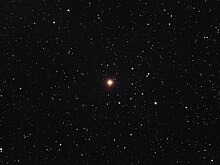Star in the constellation Auriga
π Aurigae (center) in optical light Pi Aurigae , Latinized from π Aurigae, is the Bayer designation for a single, red-hued star in the northern constellation of Auriga . Located about one degree north of the 2nd magnitude star Beta Aurigae , Pi Aurigae is visible to the naked eye with an apparent visual magnitude of 4.25 Based upon parallax measurements, it is approximately 720 light-years (220 parsecs ) away from Earth. At that distance, the brightness of the star is diminished by 0.54 in magnitude from extinction caused by interstellar gas and dust .
Pi Aurigae is an evolved bright giant star with a stellar classification of M3 II. After exhausting the supply of hydrogen at its core the star has expanded to approximately 219 times the size of the Sun. It is classified as a slow irregular variable of type LC and its brightness varies from magnitude +4.24 to +4.34. On average, the star is radiating 6,630 times the Sun's luminosity from its enlarged photosphere at an effective temperature of 3,525 K.
References
^ Vallenari, A.; et al. (Gaia collaboration) (2023). "Gaia Data Release 3. Summary of the content and survey properties" . Astronomy and Astrophysics . 674 : A1. arXiv :2208.00211 . Bibcode :2023A&A...674A...1G . doi :10.1051/0004-6361/202243940 . S2CID 244398875 .
Gaia DR3 record for this source at VizieR .
^ Johnson, H. L.; et al. (1966), "UBVRIJKL photometry of the bright stars", Communications of the Lunar and Planetary Laboratory , 4 (99): 99, Bibcode :1966CoLPL...4...99J .
Eggen, Olin J. (July 1992), "Asymptotic giant branch stars near the sun", Astronomical Journal , 104 (1): 275–313, Bibcode :1992AJ....104..275E , doi :10.1086/116239 .
^ Morgan, W. W.; Keenan, P. C. (1973), "Spectral Classification", Annual Review of Astronomy and Astrophysics , 11 (1): 29, Bibcode :1973ARA&A..11...29M , doi :10.1146/annurev.aa.11.090173.000333 .
^ Ruban, E. V.; et al. (September 2006), "Spectrophotometric observations of variable stars", Astronomy Letters , 32 (9): 604–607, Bibcode :2006AstL...32..604R , doi :10.1134/S1063773706090052 , S2CID 121747360 .
^ Famaey, B.; et al. (January 2005), "Local kinematics of K and M giants from CORAVEL/Hipparcos/Tycho-2 data. Revisiting the concept of superclusters", Astronomy and Astrophysics , 430 (1): 165–186, arXiv :astro-ph/0409579 , Bibcode :2005A&A...430..165F , doi :10.1051/0004-6361:20041272 , S2CID 17804304 .
Anderson, E.; Francis, Ch. (2012), "XHIP: An extended hipparcos compilation", Astronomy Letters , 38 (5): 331, arXiv :1108.4971 , Bibcode :2012AstL...38..331A , doi :10.1134/S1063773712050015 , S2CID 119257644 .
^ McDonald, I.; Zijlstra, A. A.; Watson, R. A. (2017-10-01), "Fundamental parameters and infrared excesses of Tycho-Gaia stars", Monthly Notices of the Royal Astronomical Society , 471 (1): 770–791, arXiv :1706.02208 , Bibcode :2017MNRAS.471..770M , doi :10.1093/mnras/stx1433 , ISSN 0035-8711 Pi Aurigae's database entry at VizieR .
^ Wu, Yue; et al. (January 2011), "Coudé-feed stellar spectral library - atmospheric parameters", Astronomy and Astrophysics , 525 : A71, arXiv :1009.1491 , Bibcode :2011A&A...525A..71W , doi :10.1051/0004-6361/201015014 , S2CID 53480665 .
"pi. Aur -- Pulsating variable Star" , SIMBAD Centre de données astronomiques de Strasbourg , retrieved 2012-08-20.Eggleton, P. P.; Tokovinin, A. A. (September 2008), "A catalogue of multiplicity among bright stellar systems", Monthly Notices of the Royal Astronomical Society , 389 (2): 869–879, arXiv :0806.2878 , Bibcode :2008MNRAS.389..869E , doi :10.1111/j.1365-2966.2008.13596.x , S2CID 14878976 .
O'Meara, Stephen James (2007), Steve O'Meara's Herschel 400 Observing Guide Cambridge University Press , p. 23, ISBN 978-0521858939
External links
Categories :
Pi Aurigae
Add topic
Text is available under the Creative Commons Attribution-ShareAlike License. Additional terms may apply.
**DISCLAIMER** We are not affiliated with Wikipedia, and Cloudflare.
The information presented on this site is for general informational purposes only and does not constitute medical advice.
You should always have a personal consultation with a healthcare professional before making changes to your diet, medication, or exercise routine.
AI helps with the correspondence in our chat.
We participate in an affiliate program. If you buy something through a link, we may earn a commission 💕
↑

